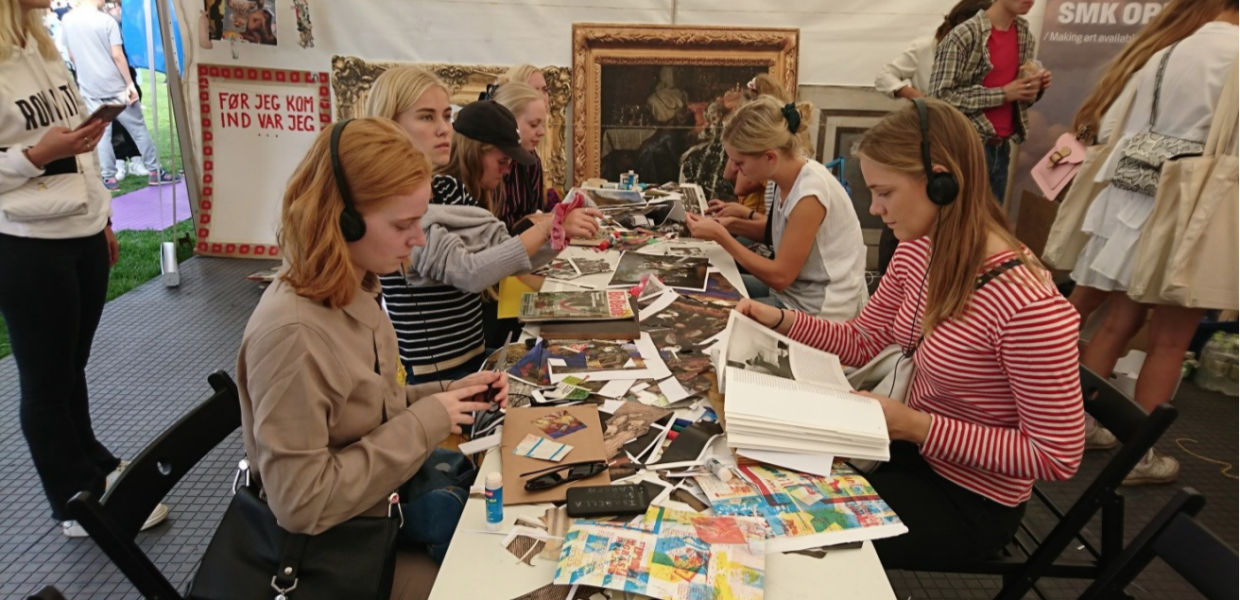The Taboo Workshop Make the Invisible Visible used freely reusable public domain artworks as a conversation-starter among young people taking part in the Young People's Meeting in Copenhagen 6-8 September 2018. The Young People's Meeting attracts more than 30,000 youngsters every year. In a collaboration with six NGO's, the workshop invited participants to create visual expressions of the difficult emotions that are shared across mental and physical disorders, by discussing, clipping, and remixing artworks from the SMK collection.
The workshop was co-organised between SMK Open, SMK's creative community Young People's Art Labs (ULK), and six NGO's working with young people who struggle with mental or physical disorders that are tabooed.
What is the impact assessment looking to show, to who and why?
At workshop level, we were curious to see if the creative act of clipping and remixing artworks could enable fruitful discussions and foster greater understanding of difficult topics and life situations among young people. On a more general level, we were looking to explore how it influences and possibly changes young people's relation to art, museums, and cultural heritage when they get free and open access to digitized artworks.
The impact assessment is a first attempt at collecting qualitative data about the possible impact an open and freely usable digitized cultural heritage can have in young people's everyday lives, and on their perception of art, museums, and cultural heritage in society.
What data is collected, from who and what methods are used
An independent anthropologist and expert in user studies prepared and conducted a series of interviews with workshop participants immediately after the workshop. 5 groups of high school kids (16-19 years old), 4 teachers, 3 representatives from the NGO's, and 2 representatives from ULK were interviewed (questions in Appendix). Observations were also made of the overall quantitative reach of ULK and SMK Open being present at the Young People's Meeting.
Over 100 youngsters joined the various activities offered throughout the event 6-8 September, with more than 70 taking part in the Taboo Workshop. What are the highlights of the impact assessment Rich information was found in the statements of young people having participated in the Taboo Workshop, and key stakeholders around them. Together, they identify ways in which open access to cultural heritage can be a catalyst for playful learning, personal development, active engagement in important issues, and development towards greater human understanding
What is learned from this, and what’s next?
We were able to increase our understanding of how playful participation and engaging creative practices can help bring art and museums at eye level with young people, making them feel empowered to explore and learn about different cultures and ways of life, and about themselves by engaging with cultural heritage as a tool box.
The study demonstrates that working creatively with art entails two primary outcomes when it comes to tackling difficult emotions:
- Expression – users say that the creative process is an icebreaker that enables them to put into words and/or images the difficult emotions they feel or are confronted with in others, helping them grow and show empathy
- Impression – users say that working creatively and intuitively with their hands provides a breathing hole, an open space, a chance forget oneself and to reflect on their own emotions on a deeper level This is a pilot study which will be an important basis of a two-year research project by four Danish art museums, focussing on longer term outcomes of letting young, socially fragile people meet and engage with art on a regular basis.


